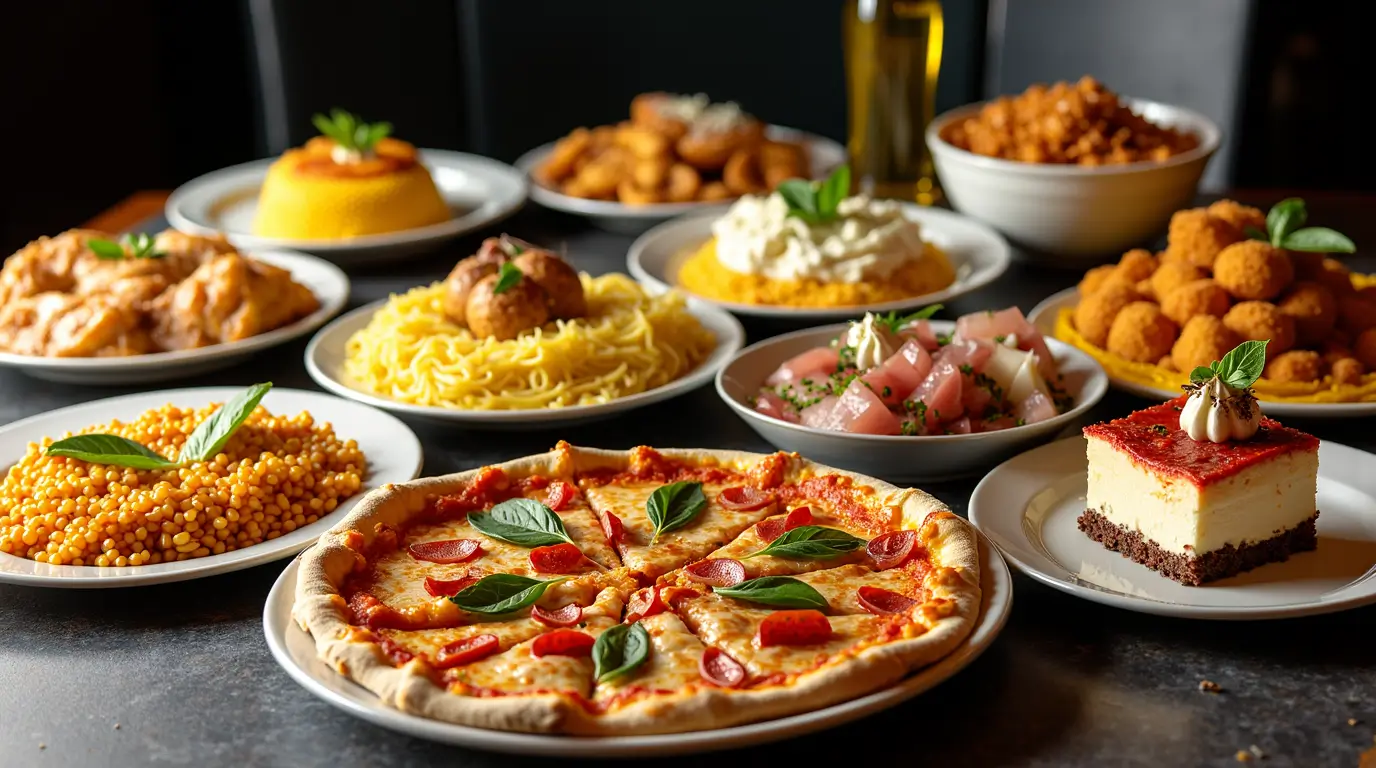Table of Contents
Introduction
Italy is a country celebrated worldwide for its rich cultural heritage, breathtaking landscapes, and, perhaps most famously, its cuisine. Italian cuisine has traveled across continents, delighting taste buds with robust flavors, fresh ingredients, and time-honored culinary traditions. When you think of Italian cuisine, images of simmering tomato sauces, perfectly al dente pasta, wood-fired pizzas with charred crusts, and fragrant olive oils may come to mind. Yet, this simplistic image of “pizza and pasta” barely scratches the surface of Italy’s gastronomic depth.
From the snow-capped peaks in the north to the sun-drenched shores in the south, Italy offers an extraordinary culinary diversity. Regional differences come alive in every corner of the country, each locale showcasing its own repertoire of dishes and techniques shaped by centuries of history and geography. This article will guide you through the rich tapestry of Italian cuisine, examining its historical roots, core ingredients, regional culinary highlights, and modern trends. By journey’s end, you will have a deeper appreciation for the complexity and vivacity of Italy’s gastronomy—an invitation to explore, experiment, and savor.
Culinary Context and History
Ancient Origins and Roman Influence
Italian cuisine’s story stretches back thousands of years. Traces of its development can be found in ancient Roman times, where lavish banquets featured bread, olives, fresh produce, and meats seasoned with herbs, honey, and the ubiquitous “garum” (a fermented fish sauce used much like we use salt or soy sauce today). Ancient Rome’s extensive trade routes brought in spices and exotic ingredients from across the empire, laying the foundations for a cuisine that would continually evolve by absorbing external influences.
The Middle Ages and Regional Fragmentation
After the fall of the Roman Empire, Italy was fragmented into various city-states and kingdoms, each with its own local rulers, dialects, and, importantly, culinary traditions. The separation gave rise to substantial regional diversity. Food was influenced by everything from geography to social class. Coastal regions, for example, relied heavily on seafood, while inland areas took advantage of fertile plains and mountainous pastures to cultivate cereals, legumes, and raise livestock.
Throughout the Middle Ages, monasteries played a crucial role in preserving agricultural knowledge and culinary practices. Monks and nuns not only grew essential herbs and maintained gardens but also documented recipes and cooking methods. The monastic contribution helped shape dishes that remain part of Italy’s gastronomic identity today.
Renaissance Splendor and Culinary Codification
The Renaissance marked a dazzling period of art, culture, and culinary sophistication in Italy. Wealthy families such as the Medici in Florence employed skilled chefs and hosted grand feasts. We see the beginnings of cookbooks and written culinary tradition emerging in this period. Noble courts innovated with sugar, spices, and new cooking techniques, all while continuing to rely on local produce. Recipes from this era showcased intricate presentations and elaborate sauces, though these were mostly accessible to the upper classes.
As powerful merchant families rose to prominence in cities like Venice, Genoa, and Florence, trade flourished. Ingredients like rice (introduced to northern Italy) and tomatoes (brought from the Americas) became integral parts of the cuisine—though tomatoes were initially met with suspicion and used primarily for decorative purposes before eventually becoming a key staple.
Influence of Migrations and Trade
Italy’s strategic position in the Mediterranean meant that its cuisine was continually enriched by the movement of people and goods. Arab influences appeared in Sicily, where citrus fruits, sugar cane, and certain spices took root. Spanish domination in parts of southern Italy brought different cooking methods and the introduction of new ingredients like peppers. The movement of individuals across different Italian regions, coupled with robust maritime and land-based trade, acted as a steady catalyst for culinary cross-pollination.
Unification and Culinary Identity
The unification of Italy in the 19th century began a process of national self-discovery, including the food culture. Though Italians became countrymen under one flag, the centuries-old regional identities persisted—and remain evident today in distinct pasta shapes, sauces, breads, and desserts. Far from being a disadvantage, this diversity is a defining strength of Italian gastronomy: it is at once a tapestry of micro-cuisines unified by an overarching philosophy of fresh, high-quality ingredients and mindful preparation.
Regional Diversity: North, Center, South, and Islands
Italian cuisine is best understood region by region. In the North (regions like Lombardy, Piedmont, and Veneto), cream-based sauces, butter, rice, polenta, and meats like veal and beef often take precedence over olive oil and tomatoes. Cheese-lovers will also be delighted, as these areas are famous for Gorgonzola, Parmesan (Parmigiano-Reggiano), and Taleggio. Meanwhile, the Center of Italy, especially Tuscany, Umbria, and Lazio, focuses on hearty soups, beans, roasted meats, and bread-based dishes. Olive oil is more frequently used here, and the local cuisine often places a spotlight on simple flavors, grilled meats, and legumes.
In the South (Campania, Calabria, Puglia, and Sicily), the Mediterranean climate blesses the fields with an abundance of sun-kissed tomatoes, peppers, eggplants, olives, and citrus fruits. Seafood forms a big part of southern menus, especially in coastal areas, and chili peppers (particularly in Calabria) add a hint of spiciness absent in many northern dishes. Finally, the Islands (Sicily and Sardinia) each possess unique gastronomic heritages shaped by external influences—Sicily with noticeable Arab and Spanish elements, and Sardinia with strong pastoral traditions focusing on lamb, sheep’s milk cheese (like pecorino), and specialties like pane carasau (thin, crisp bread).
Key Ingredients and Local Products
Emblematic Foods of the Italian Pantry
- Olive Oil (Olio d’Oliva): Italy is one of the world’s top producers of high-quality extra-virgin olive oil. This quintessential ingredient varies in flavor from region to region, from the buttery notes of Ligurian oil to the robust, peppery punch of Tuscan varieties.
- Tomatoes (Pomodori): Introduced to Italy in the 16th century from the Americas, tomatoes eventually became a staple. Today, San Marzano tomatoes from Campania hold a near-mythic status for their sweet, low-acid taste, perfect for sauce-making.
- Cheeses: Italy’s cheese repertoire is vast. Parmigiano-Reggiano, Pecorino Romano, Mozzarella di Bufala, and Gorgonzola are just a few of the better-known examples, each protected by strict production guidelines to preserve authenticity and quality.
- Pasta and Grains: Wheat—particularly durum wheat—features prominently in pasta-making. In northern regions, the staple might be polenta or risotto (made with Arborio or Carnaroli rice). The multiplicity of pasta shapes—spaghetti, penne, fusilli, orecchiette, pappardelle, lasagna, and countless more—reflects regional preferences and how well they pair with specific sauces.
- Meats and Cured Products: Pork is the primary meat in many sausages and cured meats (salumi), such as prosciutto, pancetta, and salami. Beef is also popular, especially in the north. Regions like Tuscany and Piedmont produce top-quality beef cuts. Meanwhile, salumi from Emilia-Romagna (like Mortadella di Bologna) or from Norcia in Umbria stand out in a crowded field of high-quality charcuterie.
- Fish and Seafood: Italy’s extensive coastline ensures a bounty of fish and shellfish. Anchovies, sardines, mussels, clams, and squid are favorites in southern areas. Venetian cuisine features cuttlefish ink dishes, while Livorno (in Tuscany) has its famous fish stew, cacciucco.
- Herbs and Seasonings: Basil, oregano, rosemary, sage, and thyme are key aromatic components. In Sicily, you will find abundant use of mint. Garlic, onions, chili peppers (in the south), and parsley are also widely used.
- Fruits and Vegetables: Artichokes, fennel, eggplants, zucchini, peppers, and leafy greens are integral to many Italian recipes. Citruses—like lemons from Amalfi and blood oranges from Sicily—are prized for their zest and fragrance.
Seasonality and Its Impact on Dishes
Traditional Italian cooking is deeply tied to seasonality. Menus change with the seasons to ensure the freshest ingredients:
- Spring: Expect dishes with artichokes, peas, asparagus, and early strawberries. Easter specialties include lamb roasts and sweet breads (like colomba).
- Summer: Tomatoes, peppers, zucchini, eggplant, and fresh herbs dominate. This is the season for light pasta sauces, chilled dishes, and seafood, including sardines and clams.
- Autumn: Mushrooms (particularly porcini) and truffles (in regions like Piedmont and Umbria) are highlights. Game meats like wild boar appear in stews and ragù.
- Winter: Root vegetables, hearty soups, polenta dishes, braised meats, and heavier sauces become the norm. Citrus fruits like lemons and oranges are at their best.
By following nature’s calendar, Italian cooks ensure their dishes sing with peak flavor and quality.
Purchasing Tips
- Olive Oil: Look for labels that specify “extra-virgin,” which indicates minimal processing and higher standards. Specialty stores may carry specific regional varieties.
- Cheese and Cured Meats: Seek out Italian delicatessens or high-quality grocery stores that source from Italy or local artisanal producers. Pay attention to DOP (Denominazione di Origine Protetta) labels to ensure authenticity.
- Fresh Produce: Farmer’s markets and specialty grocery stores are best for finding ripe tomatoes, herbs, and seasonal vegetables. If possible, purchase from local farmers or organic markets for fresher, more flavorful produce.
- Pasta: For everyday cooking, well-known Italian brands (often labeled with a “100% durum wheat semolina” stamp) are generally reliable. For an artisanal touch, search for small Italian brands known for bronze-cut (trafilata al bronzo) pasta.
- Seafood: If you want authentic Italian flavors, fresh is key. Buy from reputable fishmongers. For best results, inquire about the catch of the day and plan your meal around it.
Must-Try Traditional Dishes
Italian cuisine is a vast culinary universe filled with thousands of dishes. However, certain classics have become emblematic of the country’s gastronomic soul.
Pizza Margherita
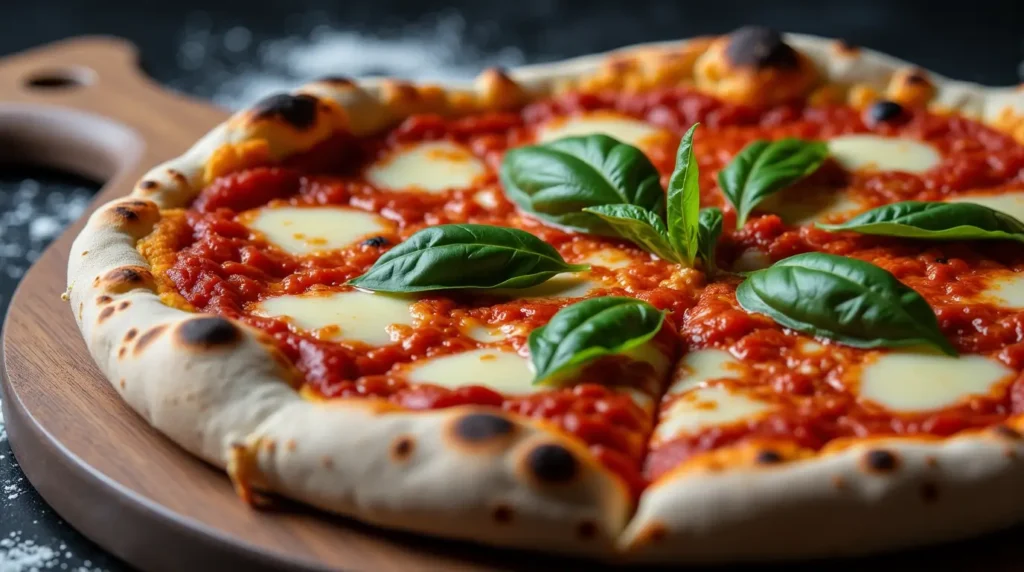
History and Characteristics: The lore goes that in 1889, Queen Margherita of Savoy visited Naples. To honor her, a local pizzaiolo, Raffaele Esposito, created a pizza with toppings that mirrored the colors of the Italian flag: red tomato sauce, white mozzarella, and green basil. Pizza Margherita is famed for its simplicity—only the best ingredients yield that perfect balance of sweet tomato, creamy cheese, and aromatic basil, all on a light yet chewy crust.
Regional Variations:
- Neapolitan pizza has a tender crust with a thicker cornicione (outer edge), cooked rapidly in a wood-fired oven.
- Roman-style pizza is thinner and crispier.
- Other Italian cities adopt unique crust thicknesses and toppings but remain faithful to simple, high-quality ingredients.
Pasta al Pomodoro (Tomato Sauce Pasta)
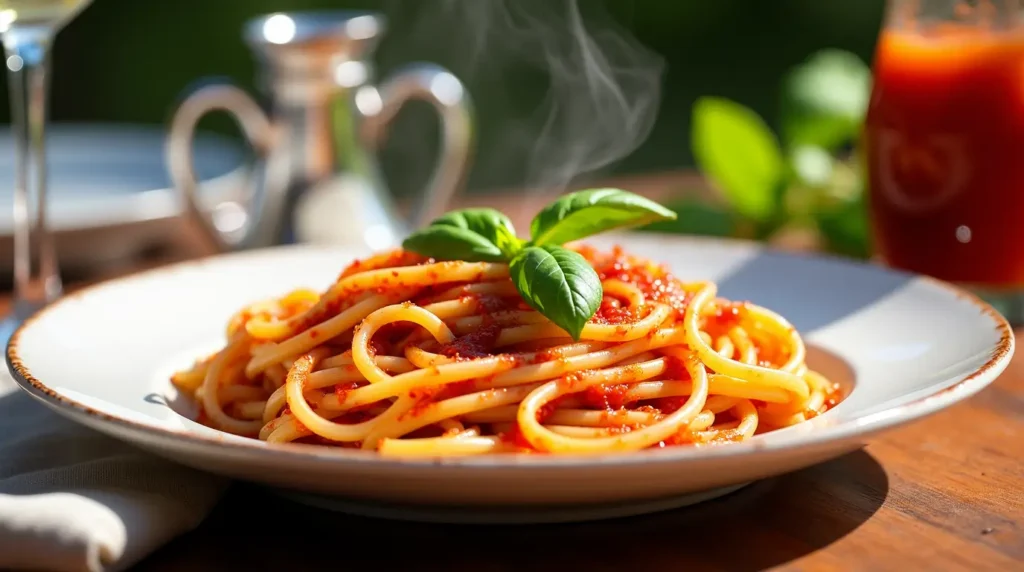
History and Characteristics: Pasta al pomodoro is the epitome of everyday Italian cooking—fresh tomatoes (or a good passata) combined with garlic, olive oil, and basil, simmered into a smooth sauce that clings perfectly to pasta. The dish finds its origins in southern Italy, where tomatoes grow abundantly and are preserved for use year-round.
Simplified Recipe:
- Ingredients (Serves 4):
- 400g pasta (spaghetti or penne)
- 2 tbsp extra-virgin olive oil
- 2 garlic cloves, crushed
- 500g ripe tomatoes (or 400g canned crushed tomatoes)
- A handful of fresh basil leaves
- Salt and pepper to taste
- Instructions:
- In a pan, warm the olive oil over medium heat.
- Add the crushed garlic and gently sauté until fragrant (avoid browning the garlic too much).
- Stir in chopped fresh tomatoes (or canned tomatoes). Season with salt and pepper.
- Let the sauce simmer for 15–20 minutes. Add basil leaves in the final minutes.
- Cook pasta in salted water according to package instructions until al dente.
- Drain and mix the pasta with the sauce. Serve hot with extra basil on top.
Risotto alla Milanese
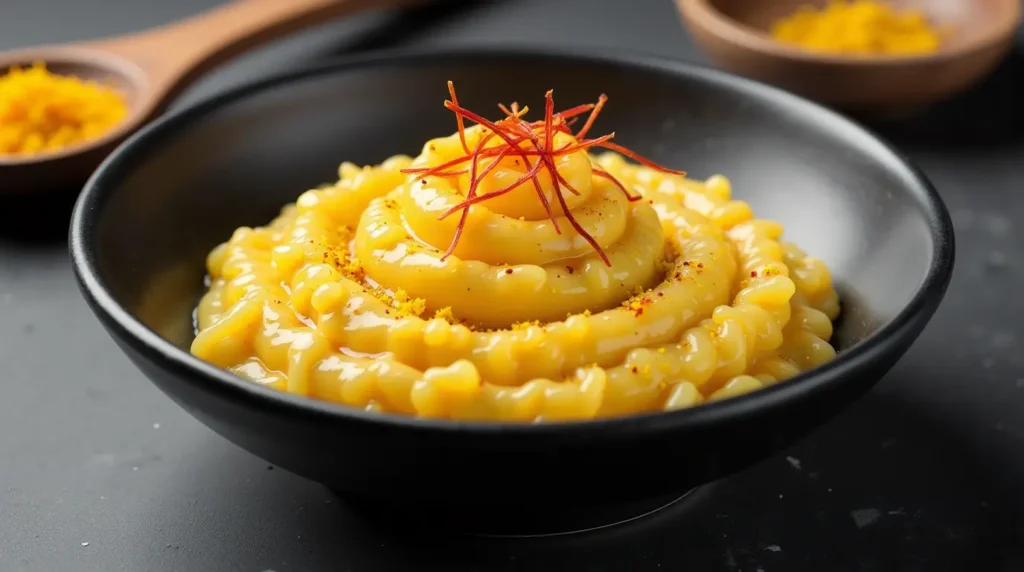
History and Characteristics: Risotto alla Milanese hails from Lombardy, in northern Italy. Its distinct golden color comes from saffron, which imparts a rich, slightly floral flavor. The risotto technique—where short-grain rice (Arborio, Carnaroli, or Vialone Nano) slowly absorbs broth—is said to have roots dating back centuries, possibly introduced through Arab or Spanish influence.
Regional Variations: While the classic risotto alla Milanese includes saffron and beef marrow, other areas produce risotto with ingredients like mushrooms, pumpkin, seafood, or cheeses. The principle remains the same: the slow addition of broth, stirred frequently to create a creamy texture without heavy cream.
Lasagna alla Bolognese
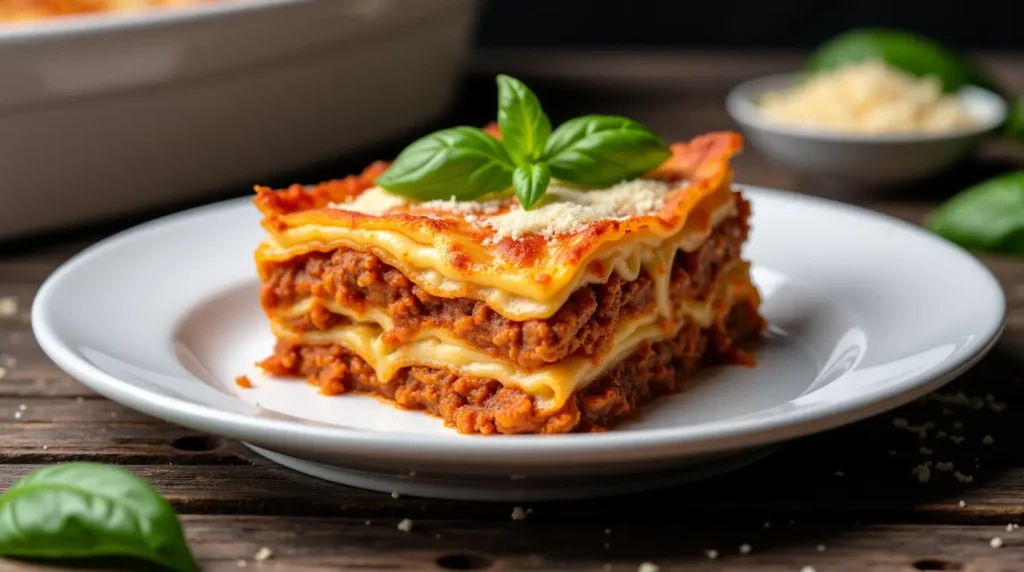
History and Characteristics: Lasagna is one of the oldest pasta dishes on record, dating back to the Middle Ages in the region of Emilia-Romagna. Traditional “lasagna alla Bolognese” features layers of handmade egg pasta sheets, ragù bolognese (a slow-cooked meat sauce), creamy béchamel, and Parmesan cheese.
Simplified Recipe:
- Ingredients (Serves 6):
- 12 lasagna sheets (fresh or store-bought)
- 500g ground beef (or a mix of beef and pork)
- 1 onion, chopped
- 1 carrot, finely diced
- 1 celery stalk, finely diced
- 400g tomato passata
- 2 tbsp olive oil
- Salt, pepper, and a pinch of nutmeg
- 2 cups béchamel sauce (homemade or store-bought)
- 100g grated Parmesan cheese
- Instructions:
- In a pot, heat olive oil and sauté onion, carrot, and celery until softened.
- Add the ground meat, cooking until browned. Season with salt, pepper, and nutmeg.
- Stir in the tomato passata; reduce heat and let it simmer for about 30–45 minutes, adding a splash of water if necessary.
- Preheat the oven to 180°C (350°F).
- In a baking dish, spread a thin layer of ragù. Top with a layer of lasagna sheets, followed by more ragù, béchamel, and a sprinkle of Parmesan.
- Repeat layers until you run out of ingredients. Finish with a top layer of béchamel and Parmesan.
- Bake for about 25–30 minutes, or until golden and bubbling.
Polenta
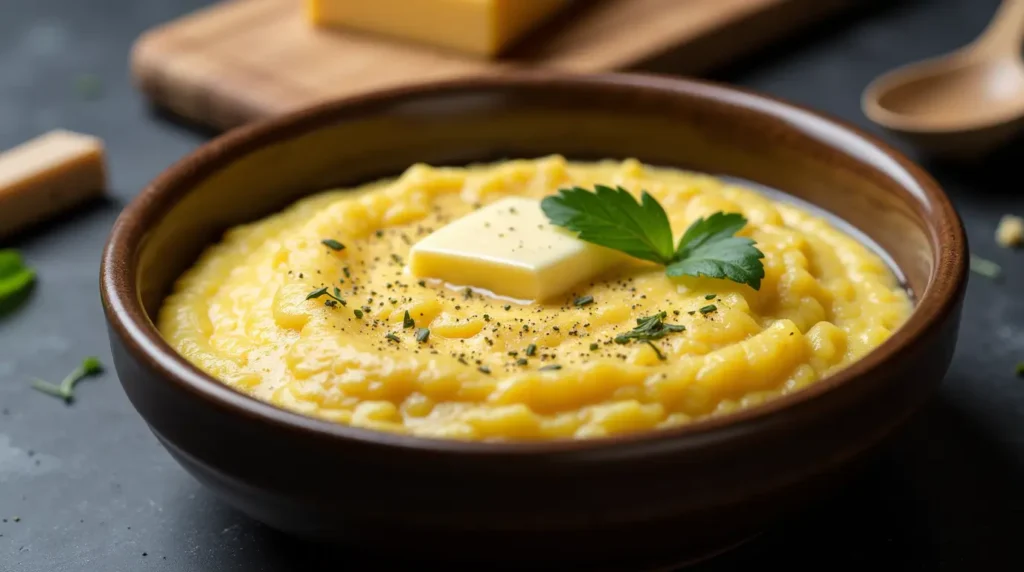
History and Characteristics: Polenta is a dish made from cornmeal, which historically served as a staple food in Italy’s northern mountainous regions. Before the introduction of corn from the Americas, similar porridges were made with other grains like buckwheat or millet. Nowadays, polenta is often served creamy or left to cool and then grilled or fried.
Regional Variations: In Veneto, polenta may accompany seafood (like baccalà mantecato—creamed cod). In Lombardy or Piedmont, it pairs with hearty stews or cheeses.
Defining Characteristics of Italian Cuisine
Flavor Profile: Balanced Yet Bold
Although Italy is often associated with robust tomato sauces and garlic aromas, the core principle is balance and freshness. Whether a dish is mild or tangy, each element complements the others without overpowering. The cuisine often relies on natural flavors of high-quality ingredients like ripe tomatoes, fresh herbs, and fragrant olive oil.
Seasonings and Flavor Combinations
- Tomato and Basil: The iconic pairing, especially in southern and central Italy.
- Garlic and Oil (Aglio e Olio): A fundamental flavor base for many sauces and dressings.
- Lemon and Olive Oil: Especially in coastal regions, used for dressing salads, seafood, or grilled vegetables.
- Truffle and Butter/Olive Oil: In fall, fresh truffles are shaved over pasta or risotto in northern and central parts of Italy.
- Herbs: Rosemary, sage, and thyme are used in roasts, stews, and focaccia, delivering an aromatic depth.
The result is a culinary style that is rarely “spicy” in the sense of hot chili peppers (except in some southern regions), but can be rich, savory, or occasionally sweet (in the case of dishes that use raisins or candied fruits in Sicilian cooking). These subtleties appeal to food enthusiasts searching for balance, freshness, and an appreciation of high-quality base ingredients rather than heavy-handed spice blends.
Tips and Highlights to Encourage People to Try Italian Cuisine
- Simplicity as Sophistication: Italian cuisine’s beauty lies in minimal yet premium-quality ingredients. A humble pasta al pomodoro can be sublime if you use top-notch tomatoes, fresh basil, and good olive oil.
- Regional Pride and Personality: Each region fiercely guards its specialties. Exploring Italy dish by dish becomes an edible journey through mountains, valleys, coastlines, and historical cross-sections of culture.
- Variety Beyond Pasta and Pizza: Though globally renowned for pasta and pizza, Italian cuisine boasts myriad options—think risotto, polenta, soups like ribollita, braised meats like osso buco, and an entire universe of cheese and cured meats.
- Cultural Immersion: Food is the heart of Italian social life. Eating Italian-style is a celebration—a way to bring family and friends together and experience a culture that values interpersonal connection as much as flavor.
- Stories and Traditions: Almost every dish has a story. From the humble origins of spaghetti alla puttanesca to the romantic tales of pizza Margherita, Italian cuisine resonates with stories passed down through generations.
Table Rituals and CustomsDaily Meal Structure
- Breakfast (Colazione): Typically light—an espresso or cappuccino with a pastry (cornetto) or simple bread with jam.
- Lunch (Pranzo): Historically the main meal of the day, though work schedules in modern times have altered this tradition. A multi-course lunch may begin with an antipasto, proceed to a primo (pasta or risotto), followed by a secondo (meat or fish) with contorno (side dish, often vegetables), and finish with fruit or a light dessert.
- Afternoon Snack (Merenda): Children might have a snack after school, such as bread with chocolate spread or a small pastry.
- Aperitivo: In many Italian cities, late afternoon or early evening is marked by an aperitivo—enjoyed in bars or cafés, featuring drinks like Aperol Spritz or Campari along with small bites or buffet-style snacks.
- Dinner (Cena): Similar structure to lunch but often lighter, particularly in the summer months. Families gather around the dinner table more so than for lunch nowadays in urban areas.
Etiquette and Local Traditions
- Pace and Pleasure: Italians place value on enjoying the meal leisurely. Meals are communal, conversation-filled events.
- Wine Culture: Wine often accompanies lunch or dinner, but it’s savored with food, not as a standalone drink. Knowing how to pair wine with a meal is considered an art.
- Gestures to Avoid: While Italians can be quite expressive with their hands, pointing at someone with utensils or raising your voice in a restaurant can be seen as rude.
- Politeness at the Table: Common courtesy dictates waiting for everyone’s food to arrive before starting, unless the host insists otherwise. Avoid cutting spaghetti with a knife; twirling pasta around the fork is preferred.
Holidays and Celebrations
- Christmas (Natale): Feasting includes fish on Christmas Eve (especially in the south), followed by roasted meats on Christmas Day, plus sweets like panettone (originally from Milan) and pandoro (from Verona).
- Easter (Pasqua): Lamb and goat are typical in many regions, and sweet breads like the colomba (dove-shaped cake) are shared.
- Ferragosto (August 15): A summer holiday with barbecues and beach gatherings.
- Family Celebrations: Birthdays, weddings, and baptisms call for elaborate meals, often served in multiple courses at home or in restaurants.
Modern Trends and Culinary Fusions
Global Influences and Fusion Cuisine
While preserving tradition remains paramount in many Italian kitchens, the 21st century has witnessed a growth in fusion experiments. Chefs exposed to global trends often incorporate ingredients like ginger, soy sauce, or exotic spices into pasta or risotto preparations—sometimes successfully, sometimes controversially. Sushi bars, poke shops, and other international eateries have also risen in popularity, particularly in cosmopolitan cities like Milan and Rome. Despite initial resistance, Italians have become more open to external gastronomic influences, paralleling broader global trends.
New Consumption Trends
- Vegetarianism and Veganism: Traditionally, Italian cuisine already provides a wide variety of vegetarian options—many pasta dishes, pizzas, and vegetable-centric recipes. However, new vegan Italian spots and creative plant-based twists on classics (e.g., vegan carbonara using tofu or chickpea flour) are becoming increasingly popular.
- Organic and Farm-to-Table: Italy’s agriturismi (farm-stay accommodations) have been strong proponents of a “farm-to-table” ethos for years, featuring produce grown on-site. Restaurants emphasizing organic produce, sustainable fishing, and local sourcing have found a receptive audience, especially among younger Italians.
- Slow Food Movement: Originating in Italy in the late 1980s, the Slow Food movement is an international campaign championing biodiversity, local food traditions, and artisanal products. This movement’s philosophy has deeply influenced modern Italian dining, promoting mindful consumption and the safeguarding of regional culinary treasures.
Young Chefs and Gastronomic Innovation
Across Italy, ambitious young chefs have taken up the mantle of tradition while weaving in elements of contemporary gastronomy. They reduce cooking times, adapt traditional dishes with new plating techniques, or incorporate underused local ingredients. Some noteworthy trends and figures:
- Michelin-Starred Revivals: In Lombardy and Piedmont, chefs elevate peasant dishes like polenta and ragù into gastronomic masterpieces, plating them in minimalist styles.
- Sustainability Focus: New restaurants in cities like Milan, Turin, and Bologna prioritize seasonal menus and minimal waste practices.
- Culinary Storytelling: Some chefs reinterpret historical recipes to create immersive dining experiences, offering narratives alongside each course, thus deepening cultural connections to the food.
Conclusion and Call to Action
Italian cuisine is more than just a collection of dishes—it’s a living tradition. Grounded in centuries of history, shaped by regional diversity, and strengthened by the country’s dedication to fresh, high-quality ingredients, it remains an endless source of culinary inspiration. From ancient Roman banquets to modern chef-driven fusion restaurants, Italy’s gastronomic landscape has continuously adapted while preserving its soul: the simplicity, honesty, and communal spirit of good food shared among friends and family.
We’ve taken a sweeping tour through the historical contexts that shaped Italy’s regional dishes, the cornerstone ingredients of its diverse pantry, and must-try classics like pizza Margherita, pasta al pomodoro, risotto alla Milanese, and lasagna alla Bolognese. Along the way, we’ve seen how local customs and traditional table rituals remain a cornerstone of Italian social life. Finally, we’ve peeked at modern evolutions that integrate global influences and new dietary trends without losing the essence of Italian culinary identity.
We invite you to share your own Italian cooking experiences—perhaps you have a family recipe passed down through generations, or maybe you’re inspired to try making fresh pasta for the first time. If you have any questions or stories about experimenting with Italian flavors, please reach out. We’d love to hear about how you bring the taste of Italy into your own kitchen.

